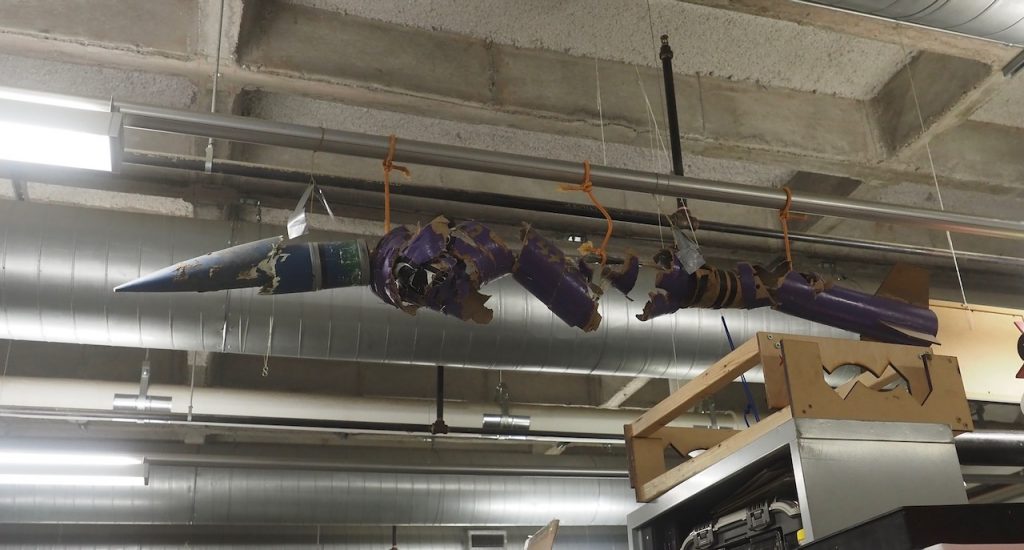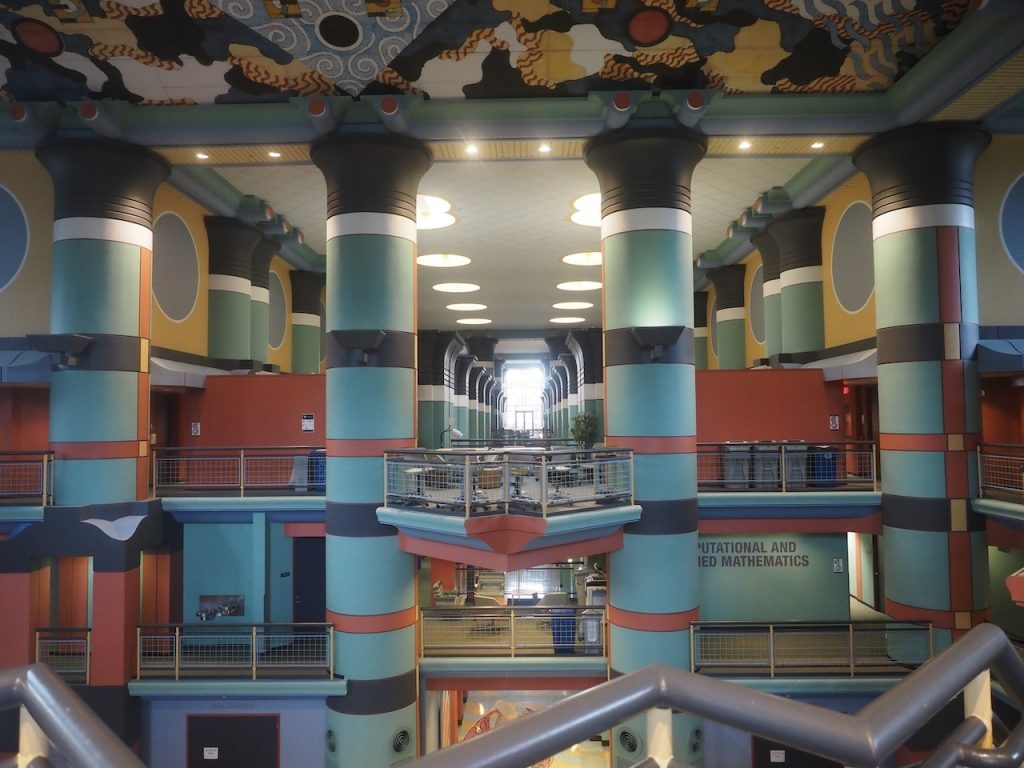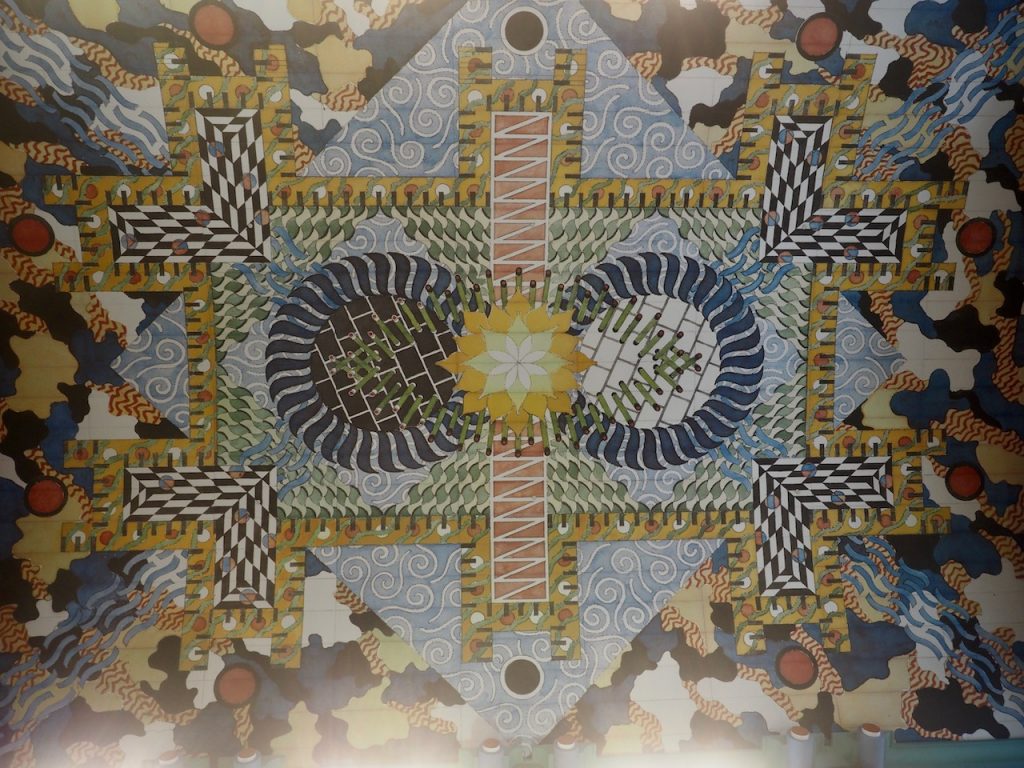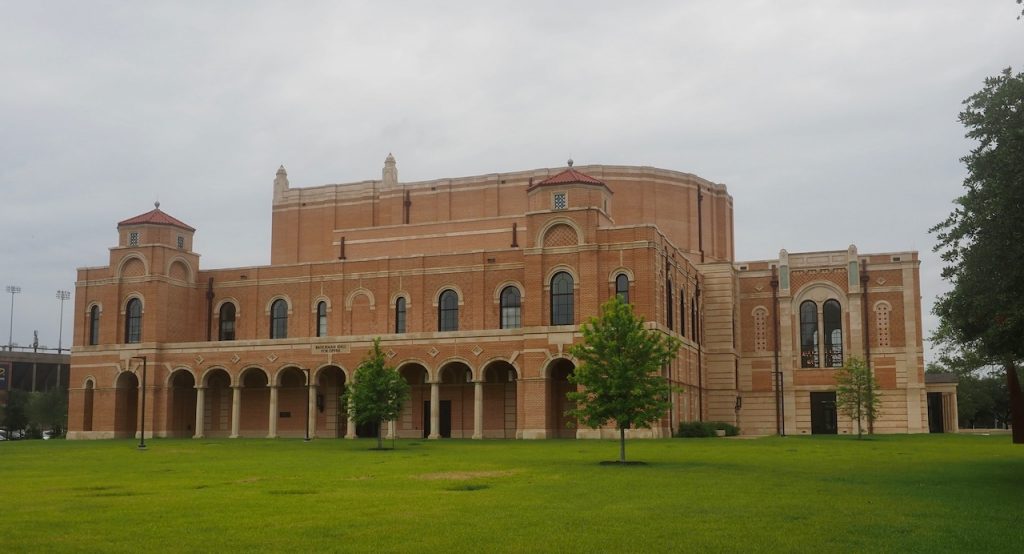After a quick breakfast (and a quick Covid test to be on the safe side, because we are in the stealth wave that is really a stealth tsunami, judging from our experience so far), Mark and I drove to my friend Tracy’s house, about 10 minutes from here on the other side of the Rice campus at about 8:45. She took us with her to campus in her Tesla, so that was fun because I’d never ridden in one–although it was Mark who got all excited about the retractable door handles and what not. We got to an underground garage on campus that wasn’t there when I went to school at Rice–and there were to be many more things throughout the day that weren’t there when I was here, beginning with the maker space, officially known as the OEDK, the Oshman Engineering Design Kitchen. Tracy, who teaches and coaches engineering students communication and writing skills, has her office in that building, so Mark got a basic tour of the design kitchen from Tracy and then talked at length to the student who was the assistant on duty (and also making a dress for his girlfriend, since there are not just laser cutters and 3-D printers, soldering stations and a big machine shop, but also a sewing machine (as well as the Eclipse Rocket club, which proudly displayed a dramatic launch blowup). In the meantime, I was looking at a self-guided tour brochure for Rice, refreshing my memory, but also discovering new things to look at later. Tracy, who had had a work meeting, joined us again, and we talked for about an hour or so while also waiting for the end of a classic Houston downpour–appropriately, about maker spaces, student challenges in engineering, and ideas for freshmen as well as capstone courses in engineering that integrate more writing and more opportunities for creativity.

When the rain stopped, Mark and I set out to walk to Rice Village in search of lunch, and opted for a small, small taco each and then a normal-size (but rather pricy) crepe for lunch. I did not recognize a single store or restaurant in the Village (studded with little stores and bespoke restaurants, but as little “student bar strip” as ever) except for a place called Le Peep, and I think I did find the spot where Foo’s Garden, a favorite Chinese place from grad student days used to be, but it was now a closed and derelict-looking Italian place that clearly did not survive the pandemic. After that, we went back to Rice–the live oaks around the inner loop and along the roads that flank the campus are as beautiful as I remembered–and peeked into several of the buildings and outdoor spaces that were favorites when I spent every weekday here, like the courtyard behind Rayzor Hall where Bruce and Steve used to smoke between classes, and the library, which I barely recognized, until I got into the familiar metal shelves and linoleum floors of the stacks. Not that it should surprise me that a first floor of a library should now be a wide open spaces with computers and glass-encased work spaces–not to mention exhibits and plaques that reckon with slavery in Texas and segregation at Rice. But it was still a jolt, given that it is one of the very few spaces that I still remember with some clarity. We also spent a bit of time exploring Duncan Hall, built in the 2000s (so after my time) and much more quirky and colorful on the inside than most other Rice buildings, with playful gestures to Mesopotamian hypostyle halls with their giant multi-color columns and Baroque ceilings rather than the cloisters-and-arcades Medieval Oxford vibe of the rest of the main campus.



The ultramodern Moody Center for the Arts was also kind of refreshing, but I am still a bit skeptical about the fortress/cathedral variant on the medieval style that was used for the brand-new opera house. What struck me most was that when I was here for 5 years, I was so both oblivious to how architecturally coherent most of the main campus really is (even though all other university campuses I had been on by the time I got to Rice in 1991 had been completely mix-and-match and utterly incoherent) and how much this approach signaled the enormous wealth of the campus. Now, that is the first thing that strikes me. This campus looks and feels beautiful, but also so rich, so unbelievably privileged–and the fact that it did start with a) a man who owned slaves until emancipation and b) who wanted an “institute” for whites only, as per Rice’s charter (not changed until the 1960s, when Rice also began charging tuition) does make me less nostalgic than queasy, even as this is now addressed (if not redressed). It sure was not in the 1990s!
By about 4:30, we were wrapping up our campus exploration, and Tracy was done with her last meeting–so she came to pick us up near the Opera Cathedral Fortress and we went back to her house, where Mark got to meet Tracy’s husband Dan and then, when she got home, their 16-year old daughter Nina, a high school sophomore hopefully heading to a language-immersion trip to Berlin in about 10 days, a trip that was postponed twice because of Covid. Then, we set up a dinner / picnic table outside in front of their house (breeze, open air, again as a covid precaution) and had a delicious beef bourguignon with potatoes, salad, and fresh bread. We talked for a couple of hours (lots to catch up on; we hadn’t seen each other in 10 years) and didn’t get back to our apartment until after 9 pm. There were some very noisy tree frogs (? or something else rhythmically buzzing that wasn’t cicadas) so it took me a long time to go to sleep, but tomorrow, we’ll have a slow morning.